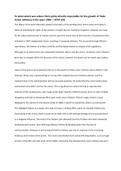To what extent was Labour Party policy directly responsible for the growth of Trade
Union militancy in the years 1964 – 1970? (25)
The Labour Party were inherently viewed as the party of the working-class, hence union and Labour’s
ideals of defending the rights of the workers, brought the two institutions together. However, the need
for the Labour government to impose controls upon the unions due to the economic circumstances they
inherited in 1964, antagonized unions, resulting in increased militancy. This occurred through Wilson’s
own failures, the failures of In Place of Strife, and the determination to impose strict regulations.
Although, to an extent there was cooperation between Labour and the unions, moreover union militancy
grew due to changes within the structure of the unions, however, the blame can be rested upon Labour
Party policy.
Labour Party policy can be deemed intrinsic to the growth of trade union militancy due to Wilson’s own
behavior. Wilson was a paranoid figure, he was often isolated due to his kitchen cabinet, and thus
viewed threats to his administration with an excessive paranoia. He stated that the union leaders were
sectionalists who didn’t care for the nation. This is significant as unions claimed to represent the
interests of the working-class, who made up the large majority of British society, hence is claim is highly
derogatory and had an alienating effect upon trade union relations. Wilson’s angry rhetoric is best
displayed in his reaction to the seamen strike of 1966, in which he named the strikers as communists.
This highlights Wilson as a leader who does not have a uniting effect, rather he inspired militancy by
illuminating to the unions that he could not be dealt with as left-leaning ideology to him was percieved
as a negative influence. The result of his rhetoric also alienated the left of Labour who were inherently
positioned with unions, thus inflaming militancy further by breaking down the channels of
communication. However, it can be argued that his rhetoric was only in response to the increasing
militancy at the heart of the unions. The unions had elected more radical left-wing leaders, such as Hugh
Scanlon of the AEU and Jack Jones of the TGWU. Inherently, this indicates that union militancy was born
, out of the unions, hence Wilson’s reactions would be naturally when confronted by a highly militant and
forceful organization. Although, his own failures to acquiesce and conciliate with trade unions
exacerbated its militant tendencies. Therefore, the aggressive rhetoric of Wilson can be deemed as
directly responsible for the growth of Trade Union militancy.
However, the Trade Unions cooperated with the Labour Party on a multitude of issues, hence devaluing
the claim that Labour was ‘directly responsible’ for growing union militancy. After the 1964 election,
Labour were welcomed by the trade unions, due to that fundamental perception of Labour being the
party of the people; a perception sustained by the retention of Clause IV. Thus, this suggests that the
Labour Party and unions had common unifying values, hence did not inherently antagonize and lead to a
growth in union militancy. Wilson required union cooperation for his 1965 DEA formed ‘National Plan’, in
which the unions agreed to a 3.5% growth rate. Hence, this evidences that Labour were not
fundamentally out to inflame tensions with the unions, rather their policy was to form links. Wilson did
this through appointing Frank Cousins as Minister of Technology in an effort to appease an influential
union figure who had helped Wilson himself become party leader. This links to the fact that the trade
unions had incredibly influence upon the Labour party internally, therefore an attack on the unions was
in essence an attack on his own party; Wilson has been critiqued as more of a party leader than a prime
minister, hence is agenda would not to be cause greater strife in his own party, and provoke union
militancy. Cooperation can also be found within the 1965 Trade Disputes Act in response to the Rookes v
Barnard ruling; Wilson reversed the ruling which essentially would have opened the unions to a
multitude of legal attacks. This intensifies the idea that Labour Party policy was to protect, not attack
unions, which would lead to increased militancy. However, this cooperation broke down as Wilson’s
administration continued, as highlighted by Cousin’s resignation in response to the Prices and Incomes
Act of 1965 which imposed controls on wage increases. This suggests that the post-war consensus of
good union relations was in a state of denigration, thus union militancy was inevitably provoked by the




